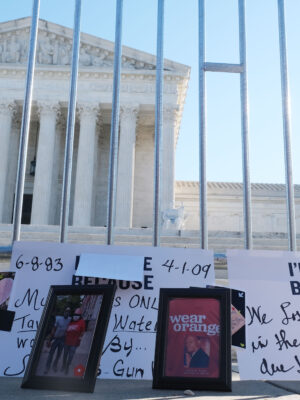Second Amendment Chaos in the Courts

By: Eric Tirschwell, Ivan Wohner 6.26.2023
The following piece ran online in The National Law Journal on June 26, 2023. Reprinted with permission.
When Congress updated the Gun Control Act (GCA) in 1994, and made it a federal crime for domestic abusers subject to protective orders to possess firearms, it’s fair to assume Zackey Rahimi was exactly who they had in mind.
In late 2019, Rahimi had an argument with his girlfriend in a parking lot, knocked her to the ground, dragged her to his car, shoved her inside causing her to hit her head on the dashboard, and then retrieved a gun and fired a shot. Later, after she escaped, he threatened to shoot her.
A Texas court granted Rahimi’s girlfriend a restraining order, which under federal law meant that Rahimi was prohibited from having a gun. But Rahimi ignored that. He later threatened another woman with a gun and then participated in a series of five shootings, including a road-rage incident and an incident where he fired a gun in the air after his friend’s credit card was declined at a restaurant. When police investigating those shootings searched Rahimi’s home, they found two firearms. Since the restraining order was still in effect, Rahimi was criminally charged with violating the GCA.
Earlier this year, a federal appeals court in Texas threw out the charges against Rahimi and said he could not be punished for violating federal law. Why? According to the court, the Second Amendment protects even someone as clearly dangerous as Zackey Rahimi.
More specifically, the judges looked back in history to when the Second Amendment was first adopted in 1791, and said that the laws on the books at that time were not similar enough to the 1994 federal prohibition on the possession of guns by those subject to a domestic violence restraining order. That, they concluded, meant that Congress could not in 1994—or now—pass a law prohibiting domestic abusers subject to civil protective orders from having guns. It was simply irrelevant to this constitutional analysis that—as the Supreme Court itself has recognized—“[a]ll too often … the only difference between a battered woman and a dead woman is the presence of a gun.”
If you are shaking your head in disbelief and wondering why today’s lawmakers should be constrained by what was or wasn’t the law 232 years ago—a time when society had a woefully deficient conception of women’s status and well before the enactment of modern laws protecting survivors of domestic violence—the answer is a highly controversial method of constitutional interpretation favored by conservatives and known as “originalism.”
One year ago, in NYSRPA v. Bruen, the Supreme Court struck down a 110-year old New York law that protected public safety by limiting who could get a license to carry a concealed weapon in public. In reaching this decision, the Court’s conservative majority adopted a text- and history-focused “originalist” test to govern all future Second Amendment challenges to gun safety laws. To decide whether a modern-day gun safety law is compatible with the Second Amendment under the historical part of that test, the Supreme Court instructed judges to go back 150 years or more and assess whether there were “analogous” laws showing that the challenged law is “consistent with this Nation’s historical tradition of firearm regulation.
But just how many laws are required to show consistency with historical tradition? Should judges look to laws around the time of the founding (when the Second Amendment was ratified) or around the time of Reconstruction (when it was applied to the states through adoption of the Fourteenth Amendment)? And just how “analogous” did a current law have to be to its historical ancestors to establish the required tradition?
Bruen answered none of these questions in any clear way.
A year’s worth of wildly contradictory decisions from the lower courts demonstrates that the Bruen dissenters were correct in their prediction that the new history-based framework would prove to be “unworkable.” Bruen has unleashed Second Amendment chaos across the country—with different judges looking at the same history and coming to diametrically opposite conclusions about the constitutionality of a wide range of gun safety laws, including whether 18- to 20-year-olds can be restricted from accessing guns, what qualifies as a “sensitive place” where guns can be prohibited, and who fits within the category of “law-abiding, responsible citizens” that the Supreme Court has said the Second Amendment protects. In fact, several other courts considering the same provision of the GCA that Rahimi challenged held that it is constitutional.
Stability and predictability are central pillars of the rule of law. Bruen provides the opposite. Courts across the country are issuing contradictory and unpredictable Second Amendment decisions virtually every week. The results leave the American public and their elected lawmakers spinning and uncertain: which existing laws will be upheld, and what new laws can be passed, as the country continues to struggle to address the ongoing epidemic of gun violence?
It is now incumbent on the Supreme Court to bring some order to the post-Bruen chaos and confirm that last year’s decision did not close the door to gun safety.
Reversing the Fifth Circuit’s dangerous decision is the most immediate opportunity for it to do so. The Court must make good on its assurance that its “originalist” test does not turn the Second Amendment into a “regulatory straightjacket” and does not mean that a modern law requires a “historical twin” to be constitutional. And it must reaffirm that—in the words of Justice Kavanaugh, in a concurring opinion joined by Chief Justice Roberts—“properly understood, the Second Amendment allows for a variety of gun regulations.”
The alternative would be tragic and deadly: a radical and dangerous interpretation of the Second Amendment frozen in a long-ago time, empowering judicial activists to fulfill the gun lobby’s dream of an America where the people are stripped of their right to enact and enforce reasonable gun laws that are proven to save lives.
Reprinted with permission from the June edition of the National Law Journal © 2023 ALM Global Properties, LLC. All rights reserved. Further duplication without permission is prohibited, contact 877-256-2472 or asset-and-logo-licensing@alm.com.
Authors
-
Eric Tirschwell
Eric brings over 30 years of litigation and trial experience to his work overseeing Everytown Law’s docket, which includes a wide range of gun industry accountability and Second Amendment litigation around the country.
-
Ivan Wohner
Ivan works with Everytown Law’s Second Amendment practice to develop robust strategies for defending state and local gun laws from constitutional challenges.




